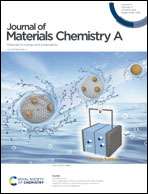Microwave-assisted solvothermal synthesis of LiVyM1−yOPO4 (M = Mn, Cr, Ti, Zr, Nb, Mo, W) cathode materials for lithium-ion batteries†
Abstract
LiVOPO4 (LVP) is a promising next generation multi-electron material with a theoretical capacity of 305 mA h g−1, higher than any commercially used cathode material. LVP still faces significant commercialization challenges, including difficulty obtaining full theoretical capacity at fast rates and capacity fading over several cycles. In this paper, we show that a low temperature microwave-assisted solvothermal synthesis yields a pure LVP material that can achieve high capacity at fast rates with decent cycle stability. There is, however, evidence of side reactions occurring during cycling starting at 4.1 V that leads to a slight degradation of capacity over time. In this paper, we also compare the effects of different substituents on the electrochemical performance of LVP. Structurally, we show the 5% Nb-substituted material adopts the beta phase, and the Ti-substituted LVP exhibits roughly 50/50 epsilon/beta phase, while all other substituents tend towards the epsilon phase. Ti-, Nb-, and Mo-substitution noticeably improved the electrochemical performance, while the other substituents either worsened or did not affect the material's electrochemical performance.



 Please wait while we load your content...
Please wait while we load your content...